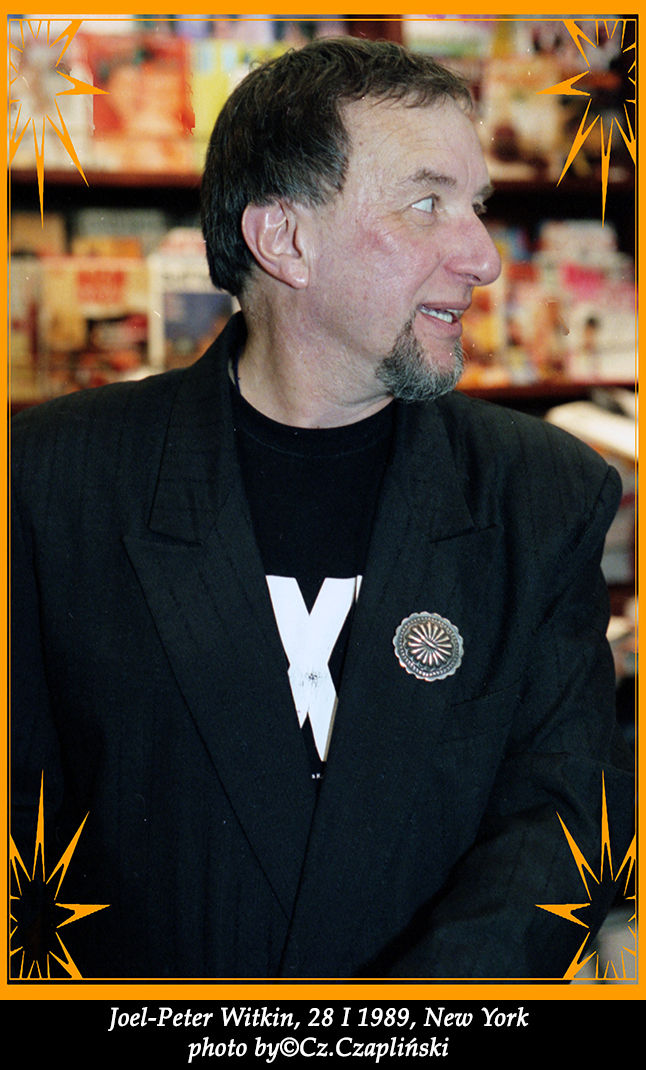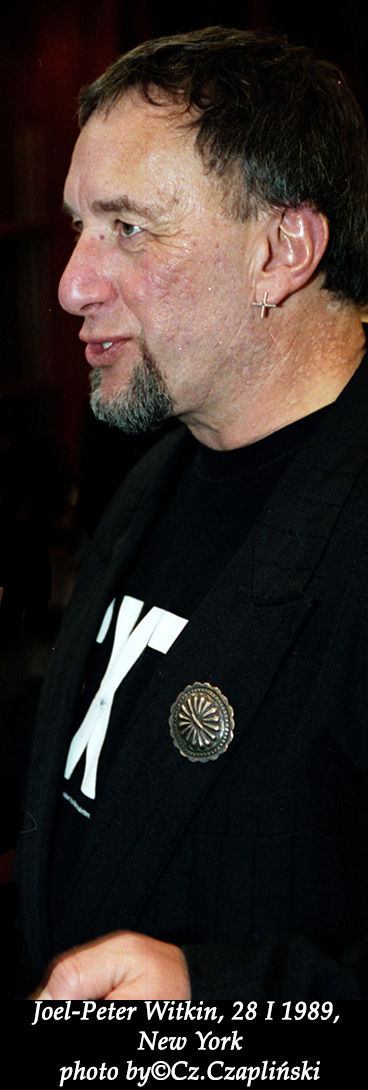PORTRET z HISTORIĄ Joel-Peter Witkin
- Czesław Czapliński

- 8 lip
- 8 minut(y) czytania

„…Nigdy nie fotografuję niczego, w co nie wierzę. Jeśli kocham pracę ze śmiercią, to dlatego, że nawet w śmierci znajduję tę moc rzeczywistości, której żaden rzeźbiarz ani malarz nie mógłby odtworzyć, nawet Michał Anioł czy Da Vinci…” – Joel-Peter Witkin.
Joel - Peter Witkin - urodzony 13 września 1939 roku w Brooklynie, w Nowym Jorku. Jest jednym z bardziej kontrowersyjnych, oryginalnych i głębokich artystów naszych czasów. Urodził się w biednej rodzinie emigrantów, jego ojciec był ortodoksyjnym rosyjskim Żydem, matka wierzącą włoską katoliczką. Był wychowywany przez babcię. Już jako młody chłopak w wieku szesnastu lat zainteresował się na poważnie fotografią. W Museum of Modern Art przedstawił się Edwardowi Steichenowi, który włączył jedno ze zdjęć Witkina do stałej ekspozycji.

„…Ludzie, którzy nienawidzą tego, co tworzę, nienawidzą również mnie. Muszą myśleć, że jestem demonem lub jakimś złym czarnoksiężnikiem. Ci, którzy rozumieją, co robię, doceniają determinację, miłość i odwagę potrzebną do odnajdywania cudów i piękna w ludziach, których społeczeństwo uważa za zepsutych, nieczystych, dysfunkcyjnych lub nieszczęśliwych…” - Joel-Peter Witkin.
To wydarzenie dostarczyło mu odpowiedniej motywacji. Pracował w fotograficznych studiach profesjonalnych Nowego Jorku. W 1961 roku został wcielony do armi, gdzie pracował jako fotograf. Jako ochotnik zgłosił sie do Wietnamu, jednak w wyniku depresji, próbował popełnić samobójstwo, po czym został zwolniony z wojska.
Po powrocie, podjął studia w Cooper Union School w Nowym Jorku, potem przeniusł się do University of New Mexico, gdzie w 1981 roku uzyskał tytuł magistra sztuk pięknych.
W 1980 roku miała miejsce pierwsza indywidualna wystawa fotografii Witkina, która zorganizował Sam Wagstaff. Od tej pory artysta jest obiektem gorączkowej i kontrowersyjnej deabaty. Szczególnie w Stanach Zjednoczonych prace Witkina budzągniew prokuratorów okręgowych i samozwańczych cenzorów kultury.
Joel - Peter Witkin nie używa komputera, do dzisiaj stosuje tradycyjne techniki fotograficzne. Swoje prace wykonuje przy użyciu dwuobiektywowego Rolleflexa z 1960 roku. Nie robi kolaży ani montaży, to co go wyróżnia to specyficzna obróbka negatywów.

„…Chciałem, aby moje fotografie były tak samo mocne, jak ostatnia rzecz, jaką człowiek widzi lub pamięta przed śmiercią…” – Joel-Peter Witkin.
Witkin bezwstydnie nazywa rzeczy po imieniu, dziwacy, karły, deformacje, demonstracje ludzie bez rąk i nóg, aranżuje swoje prace w stylu siedemnastowiecznych flamandzkich martwych natur - to niestety za dużo dla ludzi tolerancyjnych. Niektórzy postrzegają jego prace jako dziwne alegorie, kwintesencje zachodniej dekadencji. Inni porównują go do Goilub nazywaja go Hieronimem Boschem fotografii. Sztuka Witkina porusza podstawowe kwestie ludzkiej egzystencji - ból i miłość, cierpienie i radość. Jest filozofem wśród fotografów naszych czasów.

“…Ocierałem się o Witkina w ICP (International Center of Photography) w Nowym Jorku w latach 80-tych, które prowadził brat słynnego fotografa Roberta - Cornell Capa https://www.czczaplinski.com/post/portret-z-historią-cornell-capa. Ale po raz pierwszy mogłem go sfotografować 28 stycznia 1989 r. w Nowym Jorku. Pamiętam tę sesję do dziś, mimo że minęło 35 lat. Były to zdjęcia bardzo naturalne, mam na myśli niepozowane…” – Czesław Czapliński.
Fotografie Joela-Petera Witkina były wystawiane na wystawach muzealnych i galeryjnych na całym świecie, z czego ponad (150), to wystawy indywidualne. W 1996 r. Witkin miał retrospektywę w Muzeum Guggenheima w Nowym Jorku, a ostatnio, w październiku 2022 r., był częścią wystawy zbiorowej zatytułowanej Les Choses w paryskim Luwrze. Jest laureatem licznych nagród i stypendiów, w tym czterech stypendiów fotograficznych od National Endowment for the Arts. W 1990 r. został mianowany Kawalerem Sztuki i Literatury Francji, a w 2000 r. Komandorem Sztuki i Literatury Francji. Prace Witkina znajdują się w licznych kolekcjach publicznych i prywatnych na całym świecie, w tym w Museum of Modern Art (MoMA) w Nowym Jorku; w San Francisco Museum of Modern Art w Kalifornii; w National Gallery of Art w Waszyngtonie; w Centre George Pompidou w Paryżu; w Victoria and Albert Museum (V&A) w Londynie; w Centro de Arte Reina Sofia w Madrycie; Getty Museum, Los Angeles; Stedelijk Museum, Amsterdam; Metropolitan Museum of Art w Nowym Jorku i inne. Artysta mieszka obecnie w Albuquerque w Nowym Meksyku.
„… Dla mnie rzeczy ekstremalne są jak cuda. Nie ma nic nudniejszego niż osoba, która jest po prostu OK. Ale mógłbym z łatwością żyć w świecie zaludnionym tymi rozłącznymi, dziwacznymi rzeczami... Działam z powodu zamieszania, w kierunku jasności…” – Joel-Peter Witkin.
PORTRAIT with HISTORY Joel-Peter Witkin

“…I never photograph anything I don't believe in. If I love working with death, it's because even in death I find this power of reality, that no sculptor or painter could recreate, not even a Michelangelo or a Da Vinci…” – Joel-Peter Witkin.
Joel-Peter Witkin (born September 13, 1939) is an American photographer who lives in Albuquerque, New Mexico. His work often deals with themes such as death, corpses (and sometimes dismembered portions thereof), often featuring ornately decorated photographic models, including people with dwarfism, transgender and intersex persons, as well as people living with a range of physical features. Witkin is often praised for presenting these figures in poses which celebrate and honor their physiques in an elevated, artistic manner. Witkin's complex tableaux vivants often recall religious episodes or classical paintings.

“…People who hate what I make hate me, too. They must think I am a demon or some kind of evil sorcerer. Those who understand what I do appreciate the determination, love, and courage it takes to find wonder and beauty in people who are considered by society to be damaged, unclean, dysfunctional, or wretched…” - Joel-Peter Witkin.
Witkin was born to a Jewish father and Roman Catholic mother. His twin brother, Jerome Witkin, and son Kersen Witkin, are also painters. Witkin's parents divorced when he was young because they were unable to overcome their religious differences. He attended grammar school at Saint Cecelia's in Brooklyn and went on to Grover Cleveland High School.
In 1961 Witkin enlisted in the United States Army, with the intention of capturing war photography during the Vietnam War. However due to scheduling conflicts, Witkin never saw combat in Vietnam. Witkin spent his military service at Fort Hood, Texas, and was mostly in charge of Public Information and classified photos.

“…I wanted my photographs to be as powerful as the last thing a person sees or remembers before death…” – Joel-Peter Witkin.
In 1967, he became the official photographer for City Walls Inc. He attended Cooper Union in New York, where he studied sculpture, attaining a Bachelor of Arts degree in 1974. Columbia University granted him a scholarship for graduate school, but his Master of Fine Arts degree is from the University of New Mexico in Albuquerque.
Influences and themes Witkin claims that his vision and sensibility spring from an episode he witnessed as a young child, an automobile accident in front of his house in which a little girl was decapitated.
It happened on a Sunday when my mother was escorting my twin brother and me down the steps of the tenement where we lived. We were going to church. While walking down the hallway to the entrance of the building, we heard an incredible crash mixed with screaming and cries for help. The accident involved three cars, all with families in them. Somehow, in the confusion, I was no longer holding my mother's hand. At the place where I stood at the curb, I could see something rolling from one of the overturned cars. It stopped at the curb where I stood. It was the head of a little girl. I bent down to touch the face, to speak to it – but before I could touch it someone carried me away.

He says his family's difficulties also influenced his work. His favorite artist is Giotto. His photographic techniques draw on early Daguerreotypes and on the work of E. J. Bellocq.
Those of Witkin's works which use corpses have had to be created in Mexico to get around restrictive US laws. Because of the transgressive nature of the contents of his images, his works have been labelled exploitative and have sometimes shocked public opinion.
His techniques include scratching the negative, bleaching or toning the print, and using a hands-in-the-chemicals printing technique. This experimentation began after seeing a 19th-century ambrotype of a woman and her ex-lover who had been scratched from the frame.
Joel-Peter Witkin's photograph Sanitarium inspired the final presentation of Alexander McQueen’s Spring/Summer 2001 collection based on avian imagery, the walls of another box within the faux psychiatric ward collapsed to reveal a startling tableau vivant: a reclining, masked nude breathing through a tube and surrounded by fluttering moths.
In 2011, filming began on the feature-length documentary, Joel-Peter Witkin: An Objective Eye. The film, directed by Thomas Marino, examines Witkin's life and photographs. Along with interviews with Witkin, the film includes interviews from gallery owners, artists, photographers, and scholars who share insight into the impact of Witkin's work and influence on modern culture. The film was released in 2013. It will be part of the permanent collections at the Bibliothèque nationale de France in Paris, and the Biblioteca Nacional de Chile in Santiago, Chile.

Joel-Peter Witkin: An Objective Eye was first publicly shown in Santiago, Chile at the Biblioteca Nacional de Chile in 2013, as part of the opening of the exhibition, Vanitas: Joel-Peter Witkin en Chile.
In 2017, a documentary about him and his brother, Jerome Witkin, was made by Trisha Ziff, entitled Witkin and Witkin.

“…I rubbed shoulders with Witkin at ICP (International Center of Photography) in New York in the 80s, which was run by the brother of the famous photographer Robert - Cornell Capa https://www.czczaplinski.com/post/portret-z-historią-cornell-capa. But the first time I was able to photograph him was on January 28, 1989 in New York. I remember that session to this day, even though 35 years have passed. They were very natural photos, I mean unposed…” – Czesław Czapliński.
Publications: Gods of Heaven and Earth. Twelvetrees, 1989; Joel-Peter Witkin, Twelve Photographs in Gravure (1994); Harms Way: Lust and Madness, Murder and Mayhem. Twin Palms, 1994; Joel-Peter Witkin: a Retrospective. Scalo: 1995.

Exhibitions Solo exhibitions: Joel-Peter Witkin: Forty Photographs, Brooklyn Museum, Brooklyn, New York, 1986; La Jolla Museum of Contemporary Art, San Diego, CA, 1987; Vanitas: Joel-Peter Witkin en Chile, Biblioteca Nacional de Chile, Santiago, 2013. Joel-Peter Witkin: An Objective Eye documentary premiered at the opening of this exhibition.
Group exhibitions: Bodies, Fotografiska Museum, Stockholm, 2010; Heaven or Hell, Bibliothèque nationale de France, Paris, 2012.
Collections: Witkin's work is held in the following permanent collections: Art Institute of Chicago, Chicago, IL: 7 prints (as of 28 March 2023); High Museum of Art, Atlanta, GA: 1 print (as of 28 March 2023); J. Paul Getty Museum, Los Angeles, CA: 7 prints (as of 28 March 2023); Library of Congress, Washington, D.C.; Los Angeles County Museum of Art, Los Angeles, CA: 6 prints (as of 28 March 2023); Museo Nacional Centro de Arte Reina Sofía, Madrid, Spain: 3 prints (as of 28 March 2023); Philadelphia Museum of Art, Philadelphia, PA: 7 prints (as of 28 March 2023); Princeton Art Museum, Princeton, NJ: 24 works (as of 28 March 2023); San Francisco Museum of Modern Art, San Francisco, CA: 4 prints (as of 28 March 2023); Smithsonian American Art Museum, Washington, D.C.: 2 prints (as of 28 March 2023); Stedelijk Museum, Amsterdam, Holland; Whitney Museum, New York: 1 print (as of 26 March 2023).

Films about Witkin: Joel-Peter Witkin: An Objective Eye (2013) – feature-length documentary directed by Thomas Marino; Witkin and Witkin (2017) – feature-length documentary directed by Trisha Ziff, about Witkin and his brother Jerome.

“…To me extreme things are like miracles. There is nothing as boring as a person who is just okay. But I could easily live in a world populated with these disjunctive, bizarre things... I operate out of confusion, towards clarity…” –Joel-Peter Witkin.



Thanks for the insights! I’ve also gathered some useful links others might find valuable:
http://www.cosmicpharma-bd.com/online-casino-dunyasnda-kazanmann-puclar-ve-5/
http://www.donhughesgc.com/pablic/online-casino-dunyasnda-ansnz-nasl-artrrsnz/
http://www.yresearch.com.au/kumar-dunyasnda-yeni-trendler-ve-kazanma-3/
https://2025.edutechser.com/casino-dunyasnda-yeni-trendler-2024-te-neler/
https://acaciajo.com/?p=46482
https://ameliacoffee.com/index.php/2025/07/22/kumar-dunyasnda-ansnz-arttrmann-yollar/
https://barusa.com.do/kazancnz-katlayacak-en-yi-cevrimici-casino/
https://bcblacktop.com/online-casino-dunyasnda-kazanmann-stratejik-yollar/
https://brickcol.com/2025/07/22/kumar-dunyasnda-yeni-trendler-2024-te-neler/
https://bristolblockdriveways.co.uk/kumar-dunyasnda-yeni-trendler-2024-te-neler-2/
https://businesspromotionmeerut.com/2025/07/22/online-casino-dunyasnda-kazanmann-srlar-ve-puclar/
https://chancerychambers.net/online-casino-dunyasnda-kazanmann-srlar-ve-4/
https://clinicaaffonsovitola.com.br/online-casino-dunyasnda-ansnz-nasl-artrrsnz/
https://clinicaima.com.br/online-casinolarn-yukselii-ans-oyunlarndaki/
https://clinicapenaranda.com/kumar-dunyasnda-baarya-goturen-stratejiler/
https://cliniquesirine.ci/kumar-dunyasnda-yeni-trendler-kazanc-yollarnz/
https://cnv.6te.net/index.php/2025/07/22/kumar-dunyasnda-strateji-ve-ans-kazanmann-srlar-3/
https://coachingcollaborative.net/kumar-dunyasnda-strateji-ve-ans-kazanmann-srlar-2/
https://coledra.com/kumar-dunyasnda-kazanmann-srlar-stratejiler-ve-7/
https://crm.gloobo.store/cevrimici-casino-dunyasnda-kazanmann-srlar/
https://cryptohelper.in/pablic/kazanc-kapsn-aralayn-online-casino-stratejileri-ve/
https://csp.digital-solutions.ae/kumar-dunyasnda-yapay-zeka-gelecei-nasl/
https://es.austinserio.com/kumar-tutkunlar-cin-stratejik-bahis-taktikleri-ve/
https://fintlbd.com/online-casino-dunyasnda-yenilikler-2024-un-en/
https://ganpatibook.in/online-casinolarn-gelecei-yeni-trendler-ve-2/
https://greattraveladvisor.com/kumar-tutkunlar-cin-stratejik-bahis-taktikleri-ve/
https://iowabiddate.com/online-casinolarn-gelecei-dijital-dunyada/
https://jag011.jaguar-creaweb.fr/index.php/2025/07/22/kumar-dunyasnda-yeni-trendler-ve-kazanma-2/
https://jocomerford.org/2025/07/22/online-casino-dunyasnda-kazanmann-stratejik-yollar/
https://letsfixit.co.uk/diy/online-casinolarn-gelecei-yeni-trendler-ve/
https://lucyden.com/kumar-dunyasnda-kazanma-stratejileri-ansnz-nasl/
https://mapstopholidays.com/2025/07/22/online-casino-dunyasnda-kazanmann-puf-noktalar-2/
https://margaridaspousada.com.br/kumar-dunyasnda-yeni-trendler-ve-kazanma-2/
https://manuel.engineer/online-casino-dunyasnda-kazanmann-puclar-ve-5/
https://masudranabd.com/yukselen-trend-canl-casino-deneyimleri-ve/
https://www.youtheducationandsports.org/pablic-2/kumar-dunyasnda-kazanmann-srlar-stratejiler-ve-8/
https://www.lasiesta1mexicanrestaurant.com/kumar-dunyasnda-kazanmann-srlar-stratejiler-ve-8/
https://www.farmaciaferonia.ro/yukselen-trend-canl-casino-deneyimleri-ve/
https://www.conarchangels.com/online-casinolarn-gelecei-yeni-trendler-ve/
https://www.audioprotesi.org/kazancn-srr-online-casinolarn-gizli-stratejileri/
https://www.asofrayle.org/kumar-dunyasnda-yeni-trendler-kazanc-yollarnz/
https://vktpharma.com/2025/07/22/kazancnz-katlayacak-en-yi-cevrimici-casino/
https://thedorsay.com/kumar-dunyasnda-kazanmann-srlar-ve-stratejileri-3/
https://thecjdiary.com/kumar-dunyasnda-kazanma-stratejileri-ve-puclar/
https://tapetes.ciadotapete.com.br/2025/07/22/online-casino-dunyasnda-kazanmann-srlar-ve-puclar/
https://skdgroupofinstitutions.com/cevrimici-casino-dunyasnda-kazanmann-srlar/
https://sharmapg.in/online-casinolarn-gelecei-dijital-dunyada/
https://roboticurologicsurgery.com/kumar-dunyasnda-ansnz-nasl-arttrabilirsiniz/
https://revizeholy.cz/kazancnz-artrmann-yollar-online-casino-tuyolar/
https://pompes-funebres-nogaro.fr/kumar-dunyasnda-baarya-goturen-stratejiler/
http://stmaryselizabeth.org/blog/online-casino-dunyasnda-yeni-trendler-ve-3/